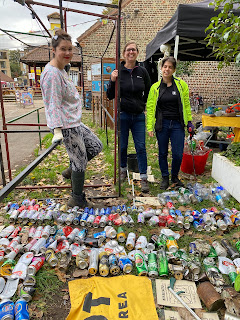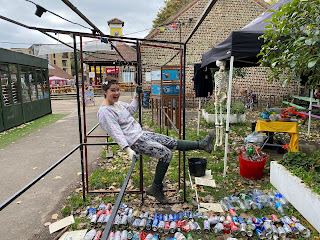It might seem obvious why I’ve named a garment encrusted with shiny things the ‘Magpie Top’, but I need to start with some mythbusting - magpies won’t steal your valuables! Recent research has suggested that magpies are indifferent to or even alarmed by shiny objects, and as vanishingly few nests have been found containing jewellery or metallic objects, these few isolated incidents have created a myth about magpies that isn’t borne out by facts. Magpies are curious, intelligent creatures, so you might see them investigating a shiny object. But instead of working out its resale value on the corvid black market, magpies are assessing the risk of this object. Is it associated with food? Or could it be poisonous? Or a trap? Clever birds like magpies will avoid items they perceive as a threat, and other corvids will copy this behaviour.
Unfortunately not all wildlife has the street smarts of a magpie when it comes to interacting with the man-made rubbish that ends up in their environments. It’s documented in famous photos like Justin Hoffman’s iconic picture Sewage Surfer, of a seahorse holding on to a cotton bud, but it’s not just happening at sea. Rubbish left in green spaces can affect all the animals that rely on that area for food and shelter. Finding a half-decomposed slug in a beer can left in the bushes is not just a uniquely disgusting experience, it’s also a problem for other animals. It might be hard to feel sorry for a slug, but that slug could have been a meal for a blackbird or thrush, or for a hedgehog.
Finding rubbish along the banks of the Wandle has been a source of unexpected artistic inspiration and fabrics galore, but it’s also been a source of frustration and distress, particularly when I’ve seen fly-tipping sites building up over months. So when the good folk at Trash Free Trails announced they were planning a Halloween Trail Clean Tour, I invited them to come and have a go at cleaning up (at least a small part of) the Wandle Trail. Their trash-busting outings usually take them to rural hiking and biking locations, so I wondered what they’d make of the Wandle Trail, and what we’d find. No one wants the dubious accolade of having the most rubbish in their local area.
We set up a base at Merton Abbey Mills, and our volunteer cohort set off along a small section of the trail to collect as much rubbish as we could. Returning with buckets full, we started the rather fascinating and occasionally revolting process of conducting a trash audit, categorising the rubbish and counting each piece. Our inventory seemed to consist overwhelmingly of beer cans, which I’d half-expected based on previous litter-picking in the area, but a chat about what wasn’t there felt quite revealing and positive. Comparing the Wandle to other trails on the tour, Dom from Trash Free Trails said he’d expected to find a lot more disposable coffee cups and fast food containers (there are a number of coffee shops and takeaways nearby), and more sandwich wrappers or food packaging (there is also a very large supermarket close by).
Litter-picking can feel like a lonely and thankless task, and it’s easy to get in your head about how selfish and careless everyone else must be. But given the amount of people using the Wandle Trail on a daily basis, this unfair assumption simply isn’t borne out by what we found. A lot of the cans we found were off the trail itself, piled up in what were obviously favourite drinking spots. I’m not going to criticise anyone for drinking in the bushes - pubs were closed for the best part of a year, and the thought of enjoying a bevvy in a secluded spot on the banks of the river sounds delightful. Enjoying a bevvy in a secluded spot surrounded by dozens of old cans, some of which contain the malodorous remains of decomposing slugs, however, sounds intensely unpleasant, and it’s preyed on my mind that this is a leisure activity in my community.
As someone prone to creating stories out of other people’s rubbish, it says something to me about the downside of city living: the overcrowded, overpriced housing that leaves people without a space to relax in after work, badly-paid jobs with long hours that leave little time or money for socialising. In other spots along the Wandle that have become ad-hoc community hubs, plenty of riverside drinking might take place, but there’s little evidence of it in the bushes the next day. Our rubbish says a lot about the state of our society, and not just through the fact that it exists at all.
While the rubbish we found might have told a rather sad tale of isolation in the big city, the litter pick told a very different story. Local business owners got involved (and donated some much-needed refreshments!), passers-by stopped to find out what was going on, to chat to the organisers and find out if this was something they could get involved with in the future. And I hope it will be! There are plenty of people who care deeply about the Wandle and its non-human inhabitants; I hope people might be inspired to pick up a picker themselves (one guy I chatted to was walking with his son, and bought his own litter picker online then and there!), contact their local council about recycling, or contact the brands who are making and selling the packaging that ends up as litter.
Unsurprisingly, I took on the task of assessing the discarded clothes and textiles we found (rotten Ralph Lauren hoodie, anyone?) and a Trash Free Trails mini-quilt might be in the works, so watch this space!








No comments:
Post a Comment